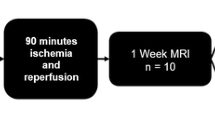Summary
This study evaluated the application of quantitative tissue velocity imaging (QTVI) in assessing regional myocardial systolic and diastolic functions in dogs with acute subendocardial ischemia. Animal models of subendocardial ischemia were established by injecting microspheres (about 300 μm in diameter) into the proximal end of left circumflex coronary artery in 11 hybrid dogs through cannulation. Before and after embolization, two-dimensional echocardiography, QTVI and real-time myocardial contrast echocardiography (RT-MCE) via intravenous infusion of self-made microbubbles, were performed, respectively. The systolic segmental wall thickening and subendocardial myocardial longitudinal velocities of risk segments before and after embolization were compared by using paired t analysis. The regional myocardial video intensity versus contrast time could be fitted to an exponential function: y=A·(1-exp−β·t), in which the product of A and β provides a measure of myocardial blood flow. RT-MCE showed that subendocardial normalized A·β was decreased markedly from 0.99±0.19 to 0.35±0.11 (P<0.05) in 28 left ventricular (LV) myocardial segments after embolization, including 6 basal and 9 middle segments of lateral wall (LW), 8 middle segments of posterior wall (PW) and 5 middle segments of inferior wall (IW). However, there was no statistically significant difference in subepicardial layer before and after embolization. Accordingly, the ratio of A·β of subendocardial myocardium to subepicardial myocardium in these segments was significantly decreased from 1.10±0.10 to 0.31±0.07 (P<0.05). Although the systolic wall thickening did not change 5 min after the embolization in these ischemic segments (29%±3% vs 31%±5%, P>0.05), the longitudinal peak systolic velocities (Vs) and early-diastolic peak velocities (Ve) recorded by QTVI were declined significantly (P<0.05). Moreover, the subendocardial velocity curves during isovolumic relaxation predominantly showed positive waves, whereas they mainly showed negative waves before the embolization. This study demonstrates that QTVI can more sensitively and accurately detect abnormal regional myocardial function and post-systolic systole caused by acute subendocardial ischemia.
Similar content being viewed by others

References
Derumeaux G, Ovize M, Loufoua J et al. Doppler tissue imaging quantitates regional wall motion during myocardial ischemia and reperfusion. Circulation, 1998,97: 1970–1977
Bai J, Deng Y B, Liu H Y et al. Myocardial velocities and strain rates in quantifying different degree of myocardial ischemia. Chin J Ultrasonogr (Chinese), 2004,13:774–776
Moore C C, Lugo-Olivieri C H, McVeigh E R et al. Three dimensional systolic strain patterns in the normal human left ventricle: characterization with tagging MR imaging. Radiology, 2000,214:453–466
Kuwada Y, Takenaka K. Transmural heterogeneity of the left ventricular wall: Subendocardial layer and subepicardial layer. J Cardiol, 2000,35:205–218
Jamal F, Kukulski T, Strottman J M et al. Quantitation of the spectrum of changes in regional myocardial function during acute ischemia in closed chest pigs: an ultrasonic strain rate and strain study. J Am Soc Echocardiogr, 2001,14:874–884
Porter T R, Xie F, Kricsfeld A et al. Noninvasive identification of acute myocardial ischemia and reperfusion with contrast ultrasound using intravenous perfluoropropane-exposed sonicated dextrose albumin. J Am Coll Cardiol, 1995,26:33–40
Wei K, Jayaweera A R, Firoozan S et al. Quantification of myocardial blood flow with ultrasound-induced destruction of microbubbles administered as a constant venous infusion. Circulation, 1998,97:473–483
Ganz P, Ganz W. Coronary blood flow and myocardial ischemia. In: Braunwald E, Zipes DP, Libby P, eds. Heart Disease: A Text Book of Cardiovascular Medicine. 6th ed. Philadelphia, Pa: WB Saunders, 2001.1087–1113
Shimoni S, Frangogiannis N G, Aggeli C J et al. Microvascular structural correlates of myocardial contrast echocardiography in patients with coronary artery disease and left ventricular dysfunction: implications for the assessment of myocardial hibernation. Circulation, 2002,106:950–956
Dijkmans P A, Knaapen P, Sieswerda G T et al. Quantification of myocardial perfusion using intravenous myocardial contrast echocardiography in healthy volunteers: comparison with positron emission tomography. J Am Soc Echocardiogr, 2006,19:285–293
Van Camp G, Ay T, Pasquer A et al. Quantification of myocardial blood flow and assessment of its transmural distribution with real-time power modulation myocardial contrast echocardiography. J Am Soc Echocardiogr, 2003,16:263–270
Akiyama M, Akasaka T, Fujimoto K et al. Heterogeneity of myocardial perfusion in distal coronary embolism with different particle sizes. J Am Soc Echocardiogr, 2006,19: 55–63
Nikitin N P, Witte K K, Thackray S D et al. Longitudinal ventricular function: normal values of atrioventricular annular and myocardial velocities measured with quantitative two-dimensional color Doppler tissue imaging. J Am Soc Echocardiogr, 2003,16:906–921
Author information
Authors and Affiliations
Additional information
Qinyang ZHANG, male, born in 1973, M.D., Ph.D.
Rights and permissions
About this article
Cite this article
Zhang, Q., Deng, Y., Liu, Y. et al. Value of quantitative tissue velocity imaging in the detection of regional myocardial function in dogs with acute subendocardial ischemia. J. Huazhong Univ. Sci. Technol. [Med. Sci.] 28, 727–731 (2008). https://doi.org/10.1007/s11596-008-0626-3
Received:
Published:
Issue Date:
DOI: https://doi.org/10.1007/s11596-008-0626-3



